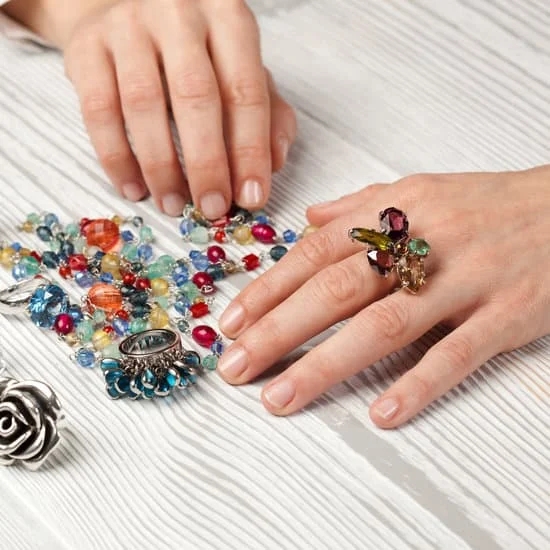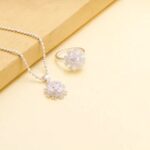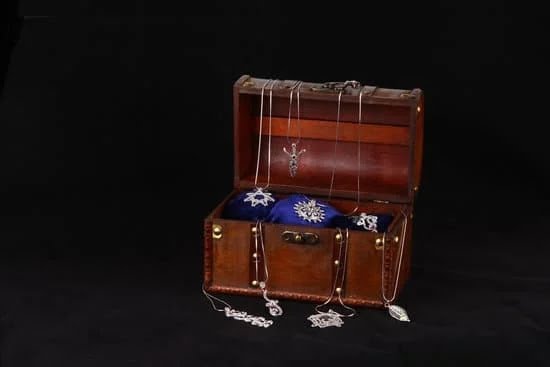The sparkle and brilliance of diamonds have long captivated us, and their addition to jewelry pieces brings a timeless elegance that is hard to resist. While larger diamonds may steal the spotlight, it is the small diamond accents that truly add a touch of magic and sophistication.
But have you ever wondered how these small diamonds are added to jewelry? In this article, we will explore the various techniques used by jewelers to incorporate these exquisite gemstones into different types of jewelry.
Diamond setting is an art in itself, requiring skill, precision, and creativity. There are several different techniques employed by jewelers to securely place small diamonds onto various settings. Each technique has its own distinct characteristics and advantages. Traditional methods such as prong setting and bezel setting have been favorites in the industry for centuries. However, as technology advances, new techniques like pavé setting, microsetting, channel setting, and invisible setting have also gained popularity.
In this article series, we will delve into each of these techniques in detail and explore how they add small diamonds to jewelry with finesse. We will look at the intricate process involved in microsetting and examine the seamless embedding of diamonds in invisible settings. Additionally, we will discuss industry innovations such as laser technology that has revolutionized diamond placement.
By understanding these methods more comprehensively, you can gain insight into the craftsmanship and attention to detail required by jewelers to create stunning diamond-accented pieces. So let’s embark on this journey through the shimmering world of small diamond accents in jewelry.
The Art of Diamond Setting
Diamond setting is an art form that requires precision and skill to create stunning pieces of jewelry. There are several different techniques used to add small diamonds to jewelry, each with its own unique characteristics and advantages. Understanding these techniques can provide insight into the craftsmanship behind the creation of diamond-accented pieces.
Prong Setting and Bezel Setting
Two traditional methods of diamond setting are prong setting and bezel setting. Prong setting involves using metal prongs to secure a diamond in place, allowing for maximum exposure of the stone’s facets. This technique is commonly used for solitaire engagement rings, as it accentuates the brilliance and beauty of a single diamond.
On the other hand, bezel setting involves creating a custom metal collar around the diamond to hold it securely in place. This technique offers excellent protection and durability for the stone, making it less prone to damage or loss. Bezel-set diamonds are popular in everyday jewelry such as earrings and pendants.
Pavé Setting
Pavé setting involves closely arranging multiple small diamonds on the surface of a piece of jewelry, giving the illusion of a paved pathway of stones. To achieve this effect, tiny holes are individually drilled into the metal surface where each diamond will be set. The diamonds are then meticulously placed into these holes, secured by shared prongs or beads.
This technique requires exceptional precision and attention to detail, as each diamond must be perfectly aligned and secured in place without any gaps or irregularities. Pavé setting is commonly used on rings and bracelets, providing added sparkle and visual interest. It is important to note that pavé settings require regular maintenance due to potential wear over time, but they can easily be restored by a skilled jeweler.
Understanding these different techniques allows consumers to appreciate the intricate craftsmanship behind small diamond accents in jewelry. Whether it is prong setting for maximum brilliance, bezel setting for protection and durability, or pavé setting for added sparkle and visual interest, each technique contributes to the beauty and allure of diamond-accented pieces. By understanding these techniques, individuals can make informed choices when selecting jewelry and gain a deeper appreciation for the art of diamond setting.
Traditional Methods
Prong Setting: Showcasing the Brilliance of Small Diamonds
One traditional method used to add small diamonds to jewelry is prong setting. This technique involves using small metal prongs, usually made of platinum or gold, to hold the diamond securely in place. The prongs are carefully positioned and then bent over the stone, creating a secure grip while allowing maximum light to enter and reflect off the diamond’s facets.
Benefits and Considerations
Prong setting offers several benefits. Firstly, it allows for excellent visibility of the diamond as minimal metal is used to hold it in place. This means that more of the diamond’s surface area is exposed, maximizing its brilliance and shine. Additionally, this setting style allows for easy cleaning of the diamond as there are no obstructions or crevices that can trap dirt or oil.
However, there are some considerations with prong setting. While this technique allows for greater light exposure and brilliance, it also means that the diamond is more susceptible to damage or loss if one of the prongs becomes loose or breaks. For this reason, regular maintenance and inspection by a professional jeweler is recommended to ensure the longevity of a prong-set piece.
Bezel Setting: A Sleek and Secure Choice
Another common traditional method for adding small diamonds to jewelry is bezel setting. In this technique, a thin band of metal (usually gold or platinum) is shaped into a circle or an oval shape that closely matches and surrounds the perimeter of the diamond. The metal is then carefully pressed over the edges of the stone, securing it firmly in place.
Advantages and Precautions
Bezel setting offers advantages in terms of security and durability. The entire circumference of the diamond is protected by metal making it less likely to dislodge or get damaged during daily wear. Furthermore, since there are no protruding prongs, bezel-set diamonds are less likely to snag on clothing or other objects, making this setting a popular choice for everyday jewelry.
It’s worth noting that bezel settings can also complement the overall design aesthetic of a piece of jewelry. By encasing the diamond in metal, jewelers have the flexibility to craft intricate or unique shapes and patterns that enhance the visual appeal of the piece.
However, some individuals may prefer prong setting over bezel setting due to the latter’s more enclosed appearance, which can create a less exposed and slightly different diamond display. Ultimately, personal preference and style should guide one’s decision when choosing between these traditional techniques for incorporating small diamond accents.
How Do They Add Small Diamonds to Jewelry Using Pavé Setting?
Pavé setting is a popular technique used to add small diamonds to jewelry, giving them a dazzling and luxurious look. This method involves setting multiple diamonds closely together, creating the appearance of a paved surface. In pavé setting, tiny holes are drilled into the metal of the jewelry piece, and each diamond is placed into these holes and secured in place using small beads or prongs.
The process of pavé setting requires precision and skill. Jewelry artisans carefully lay out the design on the metal surface, determining the exact placement for each diamond. They then use specialized tools and techniques to create small holes in the metal that perfectly fit each diamond. The diamonds are then carefully set in place, with the beads or prongs ensuring that they stay securely in position.
One advantage of pavé setting is that it allows for maximum brilliance and sparkle. The closely-set diamonds catch and reflect light from all angles, giving the jewelry piece a shimmering effect. This technique can be used to add small diamonds to various types of jewelry, including rings, bracelets, earrings, and pendants. Pavé-set diamonds are often used as accents or borders around larger gemstones or as intricate patterns on the surface of the jewelry.
Throughout history, pavé setting has been a popular choice among jewelers due to its stunning visual appeal. Its versatility and ability to enhance the beauty of any jewelry piece make it an attractive option for those looking for an exquisite touch of luxury.
| Advantages of Pavé Setting |
|---|
| Maximum brilliance and sparkle |
| Suitable for various types of jewelry |
| Enhances beauty and luxury |
The Intricate Art of Microsetting
Microsetting is one of the most intricate and detailed techniques used to add small diamonds to jewelry. This meticulous process involves setting tiny diamonds, typically less than 0.01 carats in size, into the surface of the metal using a microscope. The result is a stunning piece of jewelry with a dazzling display of diamond accents.
The process begins with the selection of high-quality diamonds that match in terms of color, clarity, and cut. These small diamonds are carefully sorted and graded by skilled gemologists before they are ready to be set into the jewelry piece.
Once the diamonds have been selected, the jeweler prepares the metal by creating small holes or recesses where each diamond will be placed. These holes are made using specialized tools such as burs or drills, ensuring that each diamond will sit securely in its designated spot.
Next, using a microscope and tweezers, the jeweler gently places each diamond into its designated hole. The diamonds are then secured in place using a mixture of adhesive and metal prongs or beads that are carefully manipulated with precision tools.
Benefits of Microsetting
Microsetting offers several benefits for adding small diamonds to jewelry. First and foremost, it allows for an incredibly precise placement of diamonds, resulting in a seamless and uniform appearance. The use of a microscope enables jewelers to work at an incredibly detailed level, ensuring that each diamond is positioned perfectly.
Furthermore, microsetting provides excellent security for small diamonds. The combination of adhesive and metal prongs or beads ensures that each diamond is held firmly in place while still allowing light to pass through for maximum brilliance and sparkle.
Moreover, microset jewelry often has a delicate and refined look due to the minimal amount of visible metal surrounding each diamond. This creates an elegant aesthetic where the focus is solely on the brilliance and beauty of the diamonds themselves.
Enhanced Brilliance
Small diamonds can add a touch of elegance and sophistication to jewelry designs. One popular technique for showcasing these small diamonds is channel setting. Channel setting is a method where the diamonds are set in a row between two parallel metal walls, creating a smooth and continuous line of sparkle. This section will explore the process of channel setting and how it enhances the brilliance of small diamonds in jewelry.
The Process of Channel Setting
In channel setting, the jeweler creates a groove or channel within the metal band where the diamonds will be placed. The width and depth of the groove are carefully calculated to ensure that the diamonds are securely held in place. Once the groove is prepared, the diamonds are individually set into it.
To secure each diamond, tiny prongs or beads of metal are pushed over its edges, holding it firmly in place while still allowing light to enter from all sides. This technique maximizes the brilliance and sparkle of each diamond by creating an uninterrupted line of light reflection.
Advantages and Considerations
One advantage of channel setting is that it provides extra protection to small diamonds compared to other techniques like prong or bezel settings. With no exposed edges or points, the chances of accidental damage or snagging on clothing are greatly reduced.
Another benefit is that channel-set jewelry has a sleek and modern appearance due to its clean lines and minimal metal visibility. This makes it an ideal choice for contemporary designs or as a complement to other diamond settings.
However, there are some considerations with channel setting. Firstly, this method requires meticulous precision from skilled craftsmen as any slight variation in measurement could result in loose stones or uneven alignment. Additionally, resizing channel-set rings can be more challenging due to potential disruption to the alignment and integrity of the stones.
Overall, channel setting provides an elegant way to showcase small diamonds by enhancing their brilliance while offering durability and protection. Whether used alone or in combination with other setting techniques, channel-set jewelry is a timeless choice for those who appreciate both style and craftsmanship.
Invisible Setting
The invisible setting is a technique used to securely and seamlessly embed small diamonds into jewelry, creating a stunning and flawless appearance. This setting method involves placing the diamonds side by side with no visible metal in between, giving the illusion that the diamonds are floating or suspended within the piece. The result is a dazzling display of diamonds that appears as if they are held in place by magic.
This intricate process requires a high level of skill and precision. The jeweler must carefully carve small grooves or “tracks” into the metal framework where the diamonds will be placed. Then, each diamond is individually cut to fit precisely into its designated groove. Once all the diamonds have been set, tiny platinum wires are inserted along the edges of the grooves to secure the stones in place.
One of the main advantages of invisible setting is that it allows for maximum light exposure to each diamond, enhancing their brilliance and sparkle. Since there is no metal separating the stones, light can pass through them more freely, resulting in a more vibrant and radiant display. Additionally, because there is minimal visible metal, the focus remains on the diamonds themselves, allowing their natural beauty to take center stage.
| Advantages | Disadvantages |
|---|---|
| – Enhanced brilliance and sparkle | – Requires highly skilled craftsmanship |
| – Seamless and flawless appearance | – Can be costly due to labor-intensive process |
| – Maximum light exposure to each diamond | – Sensitive to impact and pressure |
Overall, invisible setting offers a unique way to showcase small diamonds in jewelry. From engagement rings to pendants and bracelets, this technique creates an elegant and sophisticated look that is sure to draw attention. Although it requires highly skilled craftsmanship and can be more expensive due to the labor-intensive process, the results are truly mesmerizing.
The secret behind seamlessly embedded diamonds lies in the meticulous carving of grooves, precise diamond cutting, and careful placement by a talented jeweler. With the invisible setting, small diamonds can truly shine and captivate with their stunning brilliance.
The Role of Jewelers
Jewelers play a crucial role in the process of adding small diamonds to jewelry, as their skilled craftsmanship and attention to detail ensure that each diamond is securely and beautifully set. The art of diamond setting requires precision and expertise, and jewelers have honed their skills over years of practice to master this intricate craft.
One of the key responsibilities of jewelers is to select the most appropriate setting technique for each piece of jewelry. They take into account factors such as the design, style, and size of the jewelry, as well as the type and size of the diamonds being used. Each setting technique offers unique advantages and lends itself to different aesthetic effects.
Once the setting technique has been chosen, jewelers meticulously set each small diamond into its designated spot in the jewelry. This requires careful handling of both the diamonds and the metal components of the piece.
Jewelers must ensure that each diamond is aligned properly, sits securely in its setting, and reflects light in a way that maximizes its brilliance. Their attention to detail is paramount, as even a slight misalignment or imperfection can detract from the overall beauty and value of the jewelry.
Aside from technical skills, jewelers also bring an artistic eye to their craft. They understand how to showcase each small diamond in a way that complements and enhances the overall design of the jewelry. They consider factors such as color, clarity, shape, and arrangement when deciding on placement for each diamond. Their expertise allows them to create stunning pieces that truly showcase the brilliance and sparkle of these small diamonds.
Industry Innovations
Technology has revolutionized various industries, and the jewelry industry is no exception. One of the most significant innovations in adding small diamonds to jewelry is the use of laser technology. This advanced technique offers precise and efficient results, ensuring that the diamonds are securely set in place while maintaining the integrity of the piece.
One of the primary advantages of using laser technology for diamond setting is its precision. Traditional methods often require manual labor, which can be time-consuming and prone to human error. With laser technology, jewelers can accurately position and secure small diamonds in a fraction of the time it would take using conventional techniques.
Another benefit of laser technology is its versatility. Jewelers can use lasers to work with a variety of materials, including gold, platinum, and silver. The high-powered laser beam can modify metal surfaces by melting or evaporating them, creating intricate grooves or settings for small diamonds. This flexibility allows for greater creativity and innovation in jewelry design.
Using lasers also minimizes potential damage to the diamonds themselves. Traditional methods may involve applying heat or pressure to secure stones, which can run the risk of damaging or cracking them. Laser technology avoids these issues by providing a controlled and non-intrusive method of diamond setting. The precision and accuracy ensure that only minimal stress is applied to the stones during the process.
Ensuring Durability and Safety
Small diamond accents add a touch of elegance and sparkle to any piece of jewelry. However, ensuring the durability and safety of these small diamonds is crucial to prevent them from becoming loose or falling out. Jewelers employ various techniques to securely set these precious stones, guaranteeing that they withstand everyday wear and tear.
One of the most common methods used to secure small diamonds in jewelry is prong setting. This technique involves using small metal claws or prongs to hold the diamond in place. The number of prongs can vary, with four or six being the most common options.
This setting allows for maximum light exposure and brilliance, as minimal metal covers the diamond’s surface. However, it is important to note that over time, the prongs may wear down or become loose, leading to potential loss of the diamond if not addressed promptly.
Another popular method for securing small diamonds is bezel setting. In this technique, a metal rim surrounds the entire circumference of the diamond, holding it securely in place. Bezel setting offers excellent protection for the stone as it creates a protective barrier against accidental bumps and knocks. It is particularly suitable for smaller diamonds that may be more vulnerable to damage due to their size. Additionally, bezel setting provides a sleek and modern look to jewelry pieces.
In addition to traditional methods such as prong and bezel settings, jewelers also utilize advanced techniques to ensure maximum security for small diamonds in jewelry. One such technique is pavé setting, which involves meticulously arranging multiple tiny diamonds close together and securing them with tiny beads or mini-prongs. The result is a stunning surface fully covered with a continuous flow of diamonds that create an illusion of a solid diamond surface rather than individual stones.
By employing these different techniques such as prong setting, bezel setting, and pavé setting, skilled jewelers ensure that small diamonds are safely secured onto jewelry pieces while maintaining their brilliance and beauty. These methods not only enhance the overall aesthetic appeal but also contribute to the longevity and durability of the jewelry. With proper care and maintenance, jewelry with small diamond accents can be cherished for generations to come.
Conclusion
In conclusion, the addition of small diamond accents to jewelry is truly a display of beauty and craftsmanship. Throughout this article, we have explored various techniques used to add these precious stones, from traditional methods such as prong setting and bezel setting to more intricate processes like pavé setting and microsetting. Each technique requires skill, precision, and attention to detail, exemplifying the expertise of jewelers in their craft.
One cannot overlook the allure and enhanced brilliance that small diamond accents bring to jewelry. Channel setting seamlessly arranges these stones in a row, creating a continuous shimmer that catches the eye. The invisible setting technique takes this a step further by embedding diamonds with no visible metal between them, resulting in a flawless appearance. These techniques highlight the versatility and creativity of jewelers who constantly push boundaries to create breathtaking designs.
Furthermore, the role of skilled craftsmen cannot be overstated in this process. It is their expertise that ensures each diamond is securely set while also considering durability and safety. They understand how to manipulate metals, use laser technology effectively, and bring out the best in every piece they work on. It is through their dedication that small diamond accents continue to captivate and inspire.
Innovation plays a crucial role in the industry as well. Jewelers are always seeking new ways to improve techniques and incorporate modern technology into their craft. Laser technology has proven invaluable for precision and efficiency in adding small diamonds to jewelry. Innovations like these not only enhance the overall quality of craftsmanship but also open up new possibilities for breathtaking designs.
Frequently Asked Questions
How much does it cost to add small diamonds to a ring?
The cost of adding small diamonds to a ring can vary depending on various factors. Some key aspects that influence the price include the number and size of the diamonds to be added, their quality, and the type of setting required.
Additionally, the cost may also depend on where you choose to have this service done, as different jewelers or jewelry stores might have varying pricing structures. It is best to consult with a professional jeweler who can assess your specific requirements and provide an accurate estimate based on your preferences.
Can you add small diamonds to an existing ring?
Yes, it is possible to add small diamonds to an existing ring in most cases. However, whether or not it is feasible largely depends on the design and structure of the ring itself. Adding small diamonds usually involves modifying the setting or prongs to accommodate the additional stones.
Some rings may not be suitable for this kind of alteration due to their design intricacies or structural limitations. Nevertheless, a skilled jeweler can examine your ring and advise you on whether it is feasible to add small diamonds without compromising its integrity.
How are tiny diamonds set?
Tiny diamonds are usually set using various techniques such as bead setting, pavé setting, or channel setting. Bead setting involves arranging tiny prongs or beads around each diamond’s girdle, securing them in place while leaving a small portion exposed above the metal surface. Pavé setting entails closely placing numerous small diamonds side by side within drilled holes that match their diameter, creating an appearance similar to a “paved” surface when viewed from above.
Channel setting involves embedding tiny diamonds between parallel metal walls within a channel groove cut into the ring band itself. Each technique requires skillful craftsmanship to ensure precise placement and secure mounting of these delicate stones while maximizing their brilliance and overall visual effect in the jewelry piece.

Welcome to my jewelry blog! My name is Sarah and I am the owner of this blog.
I love making jewelry and sharing my creations with others.
So whether you’re someone who loves wearing jewelry yourself or simply enjoys learning about it, be sure to check out my blog for insightful posts on everything related to this exciting topic!





